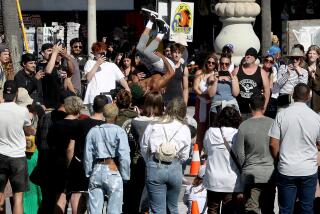Mass On-Field Viral Transmission Revealed
- Share via
Federal researchers have for the first time documented the mass transmission of a viral infection from one team to another on an athletic field.
On Sept. 20, 1998, the Duke Blue Devil football team visited the Florida State Seminoles a day after eating a box lunch containing turkey sandwiches contaminated by a Norwalk virus, which causes vomiting, diarrhea, cramps, fever and other flu-like symptoms.
More than half the Duke team was stricken on game day and the Blue Devils, expected to lose anyway, were beaten, 62-13.
But they got some measure of revenge the next day when virtually the entire Seminole offense was felled by the same virus, which they caught on the playing field.
A thorough investigation by the U.S. Centers for Disease Control and Prevention and the North Carolina Department of Health and Human Services, reported in today’s New England Journal of Medicine, eventually identified the virus and traced it to a worker at the catering service who had contracted the virus without knowing it.
The main lesson to be learned from the incident is that Duke coaches should never have allowed the sick players on the field because of the risk of infecting opponents, said Dr. Karen M. Becker, who investigated the incident for CDC. “It was a poor decision,” she said. Had the virus been more potent, the game could have ruined Florida State’s season, she added.
As it was, although Florida State won the following week, the offensive players were all still debilitated and it was “a sloppy game,” said Ross Brannon, a Seminole offensive tackle who was stricken by the virus. Had it taken them longer to recover, the game could have been lost, he conceded.
It was an evening game, the temperature was warm and there was no sign of trouble at the beginning, Florida State trainer Randy Orvitz said. But shortly after the game began, players started throwing up on the sidelines--and in some cases on the field--and suffering diarrhea.
The players rinsed their uniforms off and returned to the game, “but a couple looked pretty weak out there,” Brannon said. “Their good players’ games weren’t up to par.”
By the end of the first half, the Duke trainer came to Orvitz and borrowed IV bags because his team had already used up all of theirs. Duke Coach Fred Goldsmith spent most of the second half on his knees, doubled over with nausea.
After Duke departed, the visiting locker room “was not a pretty sight,” Orvitz said. His student assistants put on gloves and rubber booties and went in with hoses and gallons of bleach, he said. “They were not happy.”
Although Goldsmith initially blamed a pregame meal for the illness, when he returned home he found that 12 players who had not accompanied the team were in the infirmary with the same symptoms.
Meanwhile, on Monday night after the game, Florida State players began getting ill. “The whole offensive line, our quarterback, one of the student trainers and one of the fullbacks began developing all sorts of symptoms,” Orvitz said.
In all, 43 Duke players and staff who ate the box lunch on Friday became ill. They passed it on to 11 other Duke players and staff and 11 Florida State players. DNA analysis of virus collected from stool samples showed that all were infected with the same strain.
The researchers are convinced the transmission occurred during the game. “The only contact between the two teams was on the playing field,” said Dr. Christine Moe of the University of North Carolina at Chapel Hill, who participated in the investigation.
Game films showed that Duke players would unconsciously wipe their mouthpieces with their hands, then touch opponents’ faces during play. The impact of tackles, the team found, probably also vaporized tiny droplets containing the virus, which could then be breathed in by the Seminoles.
It is not clear why only Florida State’s offense was stricken, since the Duke offense and defense were on the field for an equal amount of time.
Becker, who now works for the U.S. Department of Health and Human Services’ Office of International Health and Refugee Health, was on a delayed honeymoon on North Carolina’s Outer Banks when she heard about the Duke players. She immediately returned and began interviewing them.
Her study showed that most of the ill players had eaten a turkey sandwich in a box lunch obtained from a catering service/sports bar and distributed the Friday before the game. One of the two catering service workers who prepared the lunches was subsequently found to have high levels of antibodies to the Norwalk virus in his bloodstream, although he denied ever being ill.
The investigation also showed a number of health code violations at the catering service. The facility had no separate place for washing hands, for example, and pots and pans were washed in the same sink where vegetables were rinsed. The virus could very easily have been transferred from the worker to the food, Becker said.
The violations have been fixed, Becker said, but it is unlikely that Duke will buy lunches from that establishment again.
More to Read
Go beyond the scoreboard
Get the latest on L.A.'s teams in the daily Sports Report newsletter.
You may occasionally receive promotional content from the Los Angeles Times.










